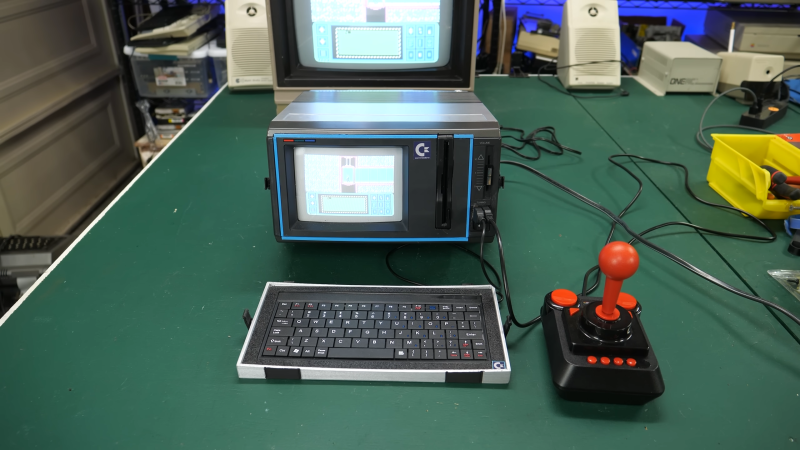When you find a portable TV from the 1980s, and it reminds you of the portable Commodore 64, there’s only one thing to be done. [Aaron Newcomb] brings us the story of taking an Emerson PC-6 and mating it to the guts of his THEC64 Mini. It’s a bit of a journey, as the process includes modding the TV to include a composite input and trimming some unused PCB off the TV’s mainboard. Then some USB ports and a three-and-a-half inch floppy drive were shoehorned into the chassis, with the rear battery compartment holding the parts from THEC64 Mini.
The build was not entirely without issue. It turns out the degaussing coil connector can plug perfectly into the service port, and Murphy’s law proved itself true again. But no harm was done, and the error was quickly discovered. All that was left was to button the chassis back up and add some paint and 3d-printed trim details. The build looks great! Come back after the break to watch the video from the [Retro Hack Shack] for yourself.

















The video is well done, I think.
There’s just one thing that seems to be a bit wrong to me.
“Composite” video is usually being associated with that yellow plug carrying a CVBS (Color VBS) signal.
A black/white monitor (greyscale, actually) doesn’t use color information, though, so it’s just plain VBS or baseband video.
It’s more like thevequivalent to the Luma input on old Commodore monitors,
which also carries sync and blanking signals like VBS does (but with different voltages, maybe. Modern S-Video uses different levels than old Luma/Chroma inputs).
Or let’s say “AV” connection, like old VCR did on their chassis. That can be either color or monochrome. 🙂
It’s still composite even without the colour signal.
Hey, I never thought of that, but it must be true – the sync is embedded in the same signal.
Hi there, please re-read my comment carefully, my point was that “composite” video these days is often being associated with the yellow RCA plug and with a combined luma+chroma signal.
That’s why some people say “monochrome composite”, to distinguish from normal composite video.
The luma signal, -which typically is not being called composite-, of S-Video plug is equal to plain VBS.
Luma pin (Y) carries the monochrome video (intensity), sync and blanking. But it’s not “composite video”.
The color information is separate on the Chroma pin (C), though.
Why are you talking about a monochrome monitor, though? The project uses a color TV (hence the degaussing coil mentioned in the article) so it does, in fact, accept a composite (CVBS) video signal.
I’ve just spooled to the end of the video. You’re right, it’s a color model. My bad, I’ve made a wrong assumption here. To me, it looked like a typical 1980s radio/tv combo to me and the way the YouTuber spoke about it being old didn’t make think otherwise.
Because, color models of that type weren’t that often to be seen, I think. At least not in direct comparison to the huge masses of b/w models out there.
Thinking that the TV is b/w is an understandable assumption, however in order to prevent that confusion color TV’s in the 80’s had a “logo” that indicated that the device was a model capable of producing color images. This way you could see it was a “fancy” color TV even when it wasn’t on. This logo consisted of 3 rectangles of the colors red-green-blue, in the screenshot of the video it is clearly visible. Please look at the top-left corner of the device.
Thank you for the information, I fully agree. 🙂👍
Great project.
Over the years, I have modified several small tv sets for direct video input. The circuitry is not so complex that you can’t reverse engineer video circuitry with a DMM and some common sense, but having schematics really makes life much easier.
Anyone know of a repository for schematics of this type? Particularly in the the case of latter-year Chinese import mini-sets, I find schematics have been notoriously difficult to find.
By the way… if you attempt something like this, make sure your proposed monitor TV is not a hot chassis set ( if it runs from batteries and has a power transformer, you’re likely OK) Fun fact: The OEM monitor for the TRS-80 Mod I was hot-chassis, so they employed an optocoupler in the interface between computer and monitor.
No color? Why bother?
Did you watch the whole video? It’s in color.
Love it, my only complaint is the name, everyone knows he should have called it the “Commodore SµX-64!”